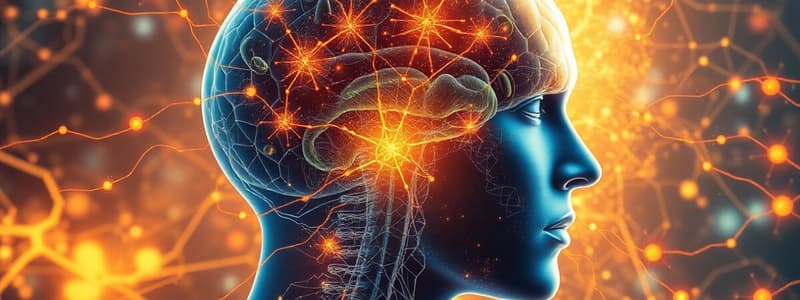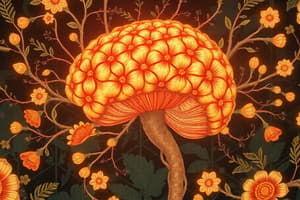Podcast
Questions and Answers
What structure insulates and speeds up the conduction of impulses in neurons?
What structure insulates and speeds up the conduction of impulses in neurons?
- Soma
- Myelin (correct)
- Dendrite
- Axon
Which type of neuron transmits impulses from sensory receptors to the CNS?
Which type of neuron transmits impulses from sensory receptors to the CNS?
- Association neurons
- Motor neurons
- Efferent neurons
- Sensory neurons (correct)
What is the function of the nodes of Ranvier?
What is the function of the nodes of Ranvier?
- Speed up impulse conduction (correct)
- Store neurotransmitters
- Connect different types of neurons
- Increase synaptic cleft size
What type of receptors respond to pain stimuli?
What type of receptors respond to pain stimuli?
In which type of synapse do neurotransmitters transfer action potential?
In which type of synapse do neurotransmitters transfer action potential?
What type of reflex results in the contraction of skeletal muscle?
What type of reflex results in the contraction of skeletal muscle?
Which part of the neuron is responsible for receiving signals?
Which part of the neuron is responsible for receiving signals?
What percentage of neurons in the body are classified as association neurons?
What percentage of neurons in the body are classified as association neurons?
What is the first step in the reflex arc?
What is the first step in the reflex arc?
Which part of the brain is primarily responsible for higher-order functions like learning and intelligence?
Which part of the brain is primarily responsible for higher-order functions like learning and intelligence?
The diencephalon includes which of the following structures?
The diencephalon includes which of the following structures?
Which statement is true regarding the function of the cerebellum?
Which statement is true regarding the function of the cerebellum?
What does the thalamus do in the brain?
What does the thalamus do in the brain?
Which of the following best describes the structure of the cerebral cortex?
Which of the following best describes the structure of the cerebral cortex?
What is the main role of the motor neuron in a reflex arc?
What is the main role of the motor neuron in a reflex arc?
Which part of the brain stem is NOT included in the collective function of the brain stem?
Which part of the brain stem is NOT included in the collective function of the brain stem?
What is the primary function of the sensory input in the nervous system?
What is the primary function of the sensory input in the nervous system?
Which division of the nervous system is primarily responsible for voluntary movements?
Which division of the nervous system is primarily responsible for voluntary movements?
What is the role of the autonomic nervous system?
What is the role of the autonomic nervous system?
Which of the following correctly differentiates between the sympathetic and parasympathetic nervous systems?
Which of the following correctly differentiates between the sympathetic and parasympathetic nervous systems?
What components make up the Central Nervous System (CNS)?
What components make up the Central Nervous System (CNS)?
Which statement about neurons is accurate?
Which statement about neurons is accurate?
What is the function of the motor output in the nervous system?
What is the function of the motor output in the nervous system?
How is the peripheral nervous system primarily categorized?
How is the peripheral nervous system primarily categorized?
What is the primary function of the pituitary gland?
What is the primary function of the pituitary gland?
Which part of the brainstem is primarily responsible for relaying sensory impulses to the thalamus?
Which part of the brainstem is primarily responsible for relaying sensory impulses to the thalamus?
What is a major consequence of increased intracranial pressure due to trauma?
What is a major consequence of increased intracranial pressure due to trauma?
Which of the following best describes the dura mater?
Which of the following best describes the dura mater?
What essential role does the pons play in brain function?
What essential role does the pons play in brain function?
What is the primary function of the subarachnoid space?
What is the primary function of the subarachnoid space?
Which statement correctly describes the pia mater?
Which statement correctly describes the pia mater?
What protects the brain from external injury and infection?
What protects the brain from external injury and infection?
What is a key function of the midbrain?
What is a key function of the midbrain?
What type of neurons exit the spinal cord via the ventral root?
What type of neurons exit the spinal cord via the ventral root?
What forms the cauda equina?
What forms the cauda equina?
Why is treatment of head injuries often complicated?
Why is treatment of head injuries often complicated?
Which layer of the meninges is located directly beneath the dura mater?
Which layer of the meninges is located directly beneath the dura mater?
Flashcards are hidden until you start studying
Study Notes
Nervous System Functions
- The nervous system has three main functions: sensory input, integration, and motor output.
- Sensory input monitors changes both inside and outside the body, like external sound waves or internal blood pressure.
- Integration processes input and decides how to respond.
- Motor output activates effectors (muscles or glands) to elicit a response, such as the heart or pancreas.
Divisions of the Nervous System
- The nervous system consists of the Central Nervous System (CNS) and the Peripheral Nervous System (PNS).
- The CNS is the integration and control center, comprised of the brain and spinal cord.
- The PNS serves as communication lines between the CNS and the rest of the body, including cranial nerves, spinal nerves, and peripheral nerves.
Peripheral Nervous System Divisions
- The PNS is divided into the sensory (afferent) and motor (efferent) divisions.
- Sensory division conducts impulses from receptors to the CNS.
- Motor division conducts impulses from the CNS to effectors.
- The motor division is further divided into the somatic (voluntary) and autonomic (involuntary) divisions.
- The somatic division controls skeletal muscles.
- The autonomic division controls smooth and cardiac muscles and glands.
- The autonomic division is further divided into the sympathetic ("fight or flight") and parasympathetic ("resting and digesting") divisions.
Neurons
- Neurons are nerve cells that can vary in length from 1 mm to over 1 m.
- Neurons generate and conduct electrical signals in one direction.
- A neuron consists of three parts: the cell body (soma), dendrites, and axon.
Myelination
- Nerve cell processes, like axons and dendrites, can be covered by a white insulation called myelin.
- Myelin is produced by Schwann cells that wrap around the axon.
- Myelin speeds up impulse conduction.
- Gaps between Schwann cells are called nodes of Ranvier.
Neuron Classification
- Neurons are classified as sensory (afferent), motor (efferent), and association neurons.
- Sensory neurons transmit impulses from sensory receptors to the CNS. Their cell bodies are located in sensory ganglia outside the CNS.
- Motor neurons carry impulses away from the CNS to effector organs (muscles or glands). Most have their cell bodies within the CNS.
- Association neurons connect sensory and motor neurons within the CNS. 99% of neurons are association neurons.
Sensory Receptors
- Sensory receptors are structures that respond to stimuli, changes in the external and internal environment.
- Sensory receptors can be modified dendritic endings or sense organs.
- Modified dendritic endings include mechanoreceptors (pressure, touch, stretch), thermoreceptors (heat), photoreceptors (light), chemoreceptors (taste, smell, O2 and CO2 levels), and nociceptors (pain).
- Sense organs include eyes and ears.
Synapses
- Synapses are junctions between two neurons, typically the axon of one with the dendrites of another, or between a neuron and an effector.
- There are two types of synapses: electrical and chemical.
- Electrical synapses are found in heart and smooth muscles for synchronized activity.
- Chemical synapses use neurotransmitters to transfer the action potential from one neuron to the next.
Reflexes
- A reflex is a rapid, predictable, involuntary motor response to a stimulus.
- Reflexes can be somatic, involving skeletal muscle contraction, or autonomic, activating involuntary muscles and glands.
- A reflex arc is a neural pathway consisting of five steps: receptor, sensory neuron, integration in CNS, motor neuron, and effector.
Central Nervous System
- The main parts of the brain are the cerebral hemispheres (cerebrum), diencephalon, brain stem, and cerebellum.
- The cerebrum is the largest part of the brain responsible for higher-order behaviors, sensory information processing, and integration of neuron activity for communication, emotional responses, learning, memory, and recall.
- The diencephalon includes the hypothalamus, thalamus, and sometimes the pituitary.
- The thalamus relays sensory impulses (except smell) to the cerebral cortex, relays motor impulses from the cerebral cortex to the spinal cord, interprets pain, temperature, light touch, and pressure sensations, and contributes to memory function.
- The hypothalamus controls autonomic functions and hormone production by the pituitary.
- The brain stem comprises the medulla, pons, and midbrain.
- The midbrain relays motor impulses from the cerebral cortex to the pons and spinal cord, relays sensory impulses from the spinal cord to the thalamus, processes visual and auditory data, moderates involuntary somatic motor reflexes, and contributes to maintaining consciousness.
- The pons relays impulses within the brain and between the brain and spinal cord, and contains involuntary somatic and visceral motor centers related to respiration.
- The medulla oblongata relays sensory impulses to the thalamus, relays motor impulses from the frontal lobe to the spinal cord, contains autonomic centers for regulating visceral (organ) function (cardiovascular, respiratory, and digestive systems), and is the site of crossover of voluntary motor pathways.
- The cerebellum controls involuntary complex somatic motor patterns, helps maintain balance, stores learned motor patterns, and adjusts output of other somatic motor centers in the brain and spinal cord for coordination and posture control.
Protection of the Brain and Spinal Cord
- The brain and spinal cord are protected by bones, meninges, cerebrospinal fluid (CSF), and the blood-brain barrier.
- The skull protects the brain, consisting of sections joined by immovable joints (synarthrodial) with sutures.
- The meninges are three layers of membranes surrounding the brain and spinal cord: dura mater, arachnoid mater, and pia mater.
- The dura mater is the tough outer layer with two layers and a space containing tissue fluids and blood vessels (sinuses).
- The arachnoid mater is a web-like middle layer lying under the dura with web-like projections connecting to the pia mater.
- The pia mater is a delicate, transparent inner layer fused to the surface of the brain and spinal cord, covering blood vessels that penetrate the brain.
- The subarachnoid space between the arachnoid and pia mater contains cerebrospinal fluid.
- The spinal cord is a two-way conduction cord between the brain and the rest of the body, and a reflex center.
- The spinal cord extends from the foramen magnum to the sixth or seventh lumbar vertebra, with lumbar and sacral nerves continuing within the vertebral canal as the cauda equina.
- Efferent axons of autonomic and somatic motor neurons leave the spinal cord through the ventral root, while afferent fibers from sensory cell neurons in dorsal root ganglia enter via the dorsal root.
- The fusion of dorsal and ventral roots on either side of the spinal cord forms the spinal nerve.
Studying That Suits You
Use AI to generate personalized quizzes and flashcards to suit your learning preferences.



